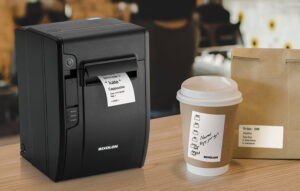Transforming Efficiency and Customer Experience within Hospitality

 By Jay Kim, Managing Director BIXOLON (www.bixoloneu.com)
By Jay Kim, Managing Director BIXOLON (www.bixoloneu.com)
The UK restaurant industry expected to grow 15% between 2022 and 2027 to £90 billion. But how are providers going to meet escalating demand for a great customer experience both eating in and via delivery apps when official figures show hospitality vacancies have risen by 72% since Brexit, while the number of EU workers in the industry has fallen by 26%? With food inflation hitting 17% in 2022, how can restaurants retain margin without passing on rising costs to cash strapped customers? And how can businesses ensure compliance to both essential food safety information and demands from both government and customers for more food ingredient information?
Jay Kim, Managing Director BIXOLON Europe GmbH, outlines five ways the hospitality industry can use intelligent printing solutions to address key operational challenges and deliver tangible return on investment.
Efficient Food Delivery
The cost-of-living crisis has shifted consumers’ attitudes to eating out, with many restaurants increasing their commitment to food aggregator services to retain profitability. Indeed, the food delivery industry is expected to grow to $320 billion by 2029, underlining the level of opportunity. However, while food delivery apps offer a great additional revenue stream, the model places new pressures on kitchen staff to meet tight turnaround times irrespective of levels of demand.
There is simply no room for errors. Food delivery apps encourage restaurants to use cloud printing to dedicated printers to get orders to the restaurants quickly and efficiently, avoiding any problems associated with orders being transcribed manually. One of the additional benefits restaurants could consider is the use of linerless printing products. In addition to the lack of wastage offered by linerless labels with no backing material, these labels can be any size – the printer simply cuts the label to fit the information printed, whether the label is for a single coffee cup or a large meal order.
Further, linerless labels can use two different adhesives – permanent or semi-permanent – allowing restaurants to embrace flexible printing. A permanent adhesive label can be printed to include customer name, address and the food order, and be used to provide an anti-tamper seal on the packaging. Additionally, semi-permanent labels can be used to automatically provide kitchen staff with the accurate information they need to complete the order, including time stamps to ensure deadlines are hit.
Maximising Staff Availability
With customers increasingly viewing ‘eating in’ as an occasion, the hospitality industry is focusing on improving the quality of experience. Given endemic staff shortages, technology is playing a vital role in supporting staff efficiency. Many restaurants use mobile devices to take customer orders which are then printed as required, in kitchen and bar areas. Adding a mobile printer to this system allows staff to handle the entire customer experience at the table. There is no need to return to the Point of Sale (POS) to print out a bill or collect the card payment system – something that can be very time consuming at peak times when there is a queue for the POS and printer.
In addition to improving the customer experience and increasing table turnover, intelligent use of printers can ensure experienced staff spend more time with customers. Touch screen printers mean every meal, coffee or drink is accompanied by its table number, allowing the restaurant to effectively use new or seasonal staff to deliver food and clear tables. This frees up the time of experienced, trusted individuals to leverage their expertise to discuss allergens, for example, explain menu items and take orders and payments. New staff can be immediately productive while the restaurant maximises the skills of longer-term employees.
High Quality Self-Service Experiences
To address the staff shortage, a growing number of restaurants are also exploring the power of customer self-service, from QR codes on the table that link to an app with the menu, to kiosks for fast food orders. App based ordering is particularly useful in high tourism areas, with the app automatically offering different language options. Customers place their orders which are immediately printed in the kitchen; once ready, the order includes the information required to ensure it goes to the right table. Because customers place their own orders, there is less risk of error; and payment can be made online, further reducing the number of staff required.
The use of kiosk systems with printers is also driving up sales – with fast food restaurants reporting customers buy between 10-20% more food when at a kiosk compared to ordering from a server. In addition to reducing the queues, which attracts more customers, people feel less pressure at the kiosk and are happy to take the time to browse through the menu, leading to larger orders. With the inbuilt printer providing the order and receipt, the entire process is both less staff dependent and more profitable.
Reducing Food Waste
With the cost of raw ingredients rising at the fastest rate in decades and supply chain shortages continuing to create challenges for restaurant kitchens, staff are under enormous pressure to minimise food wastage. Staff shortages can, again, cause problems. A lack of experience combined with staff working different shifts can make it hard to keep track of product usage, leading to unnecessary wastage of fresh items.
Using integrated tablet printers in tandem with a food labelling solution enables kitchen staff to easily keep track of items such as freshly created salads or newly opened jars. In addition to avoiding waste, an effective labelling solution improves stock rotation while also supporting the allergy reporting that is key to comply with legislation such as Natasha’s Law.
Eco-Visibility
Indeed, improving information about allergens and ingredients has become far more important in recent years, with many customers interested in the quality and history of ingredients, especially for venues with a strong local ethic. While information is available on the menu, adding specific messaging to the customer’s receipt is also powerful – especially if the restaurant embraces the new, environmentally friendly blue printer paper (e.g. Koehler’s Blue4estâ thermal paper).
As an added benefit, the new blue paper provides a great customer talking point – and demonstrates the business’ commitment to environmental issues. Unlike traditional white receipt paper, these receipts can also go directly into a customer’s food box or with open food, helping with the delivery side of the business as well.
Conclusion
Balancing cost control with improved customer experience, especially with the lack of staff, is challenging and restaurants are becoming ever more innovative and flexible as a result. But even simple changes can deliver significant benefits. Eradicating errors from the kitchen to reduce wastage and avoid delivery problems adds immediate bottom-line value. Leveraging mobile printing can maximise the skills of trusted employees to improve the customer experience. And exploring eco-friendly printing options can transform customer perception.
Restaurants that innovate today to get through this current crisis will be well placed to maximise potential when the economy improves and will be well placed to maximise the opportunities of the industry’s predicted growth.
